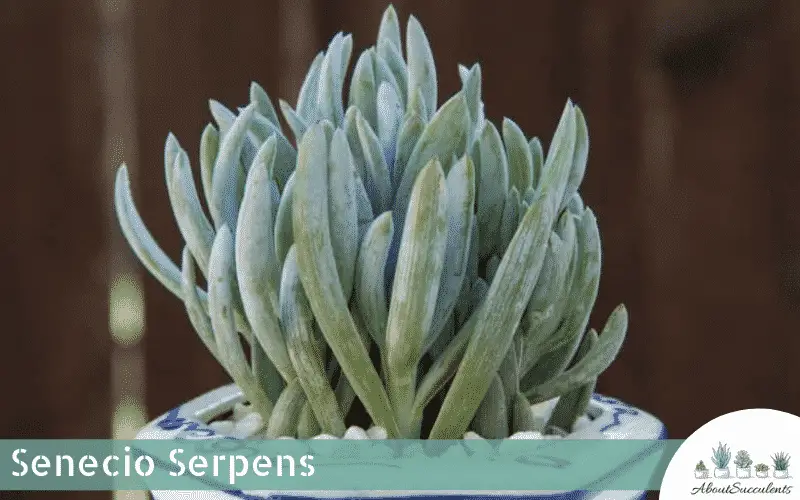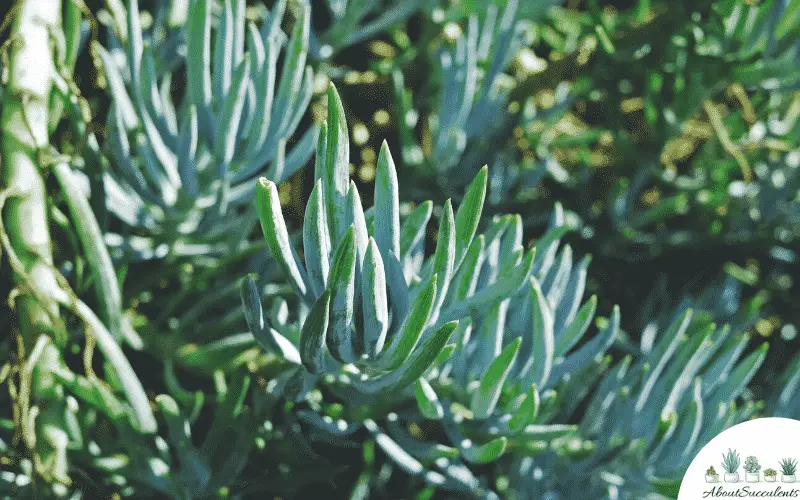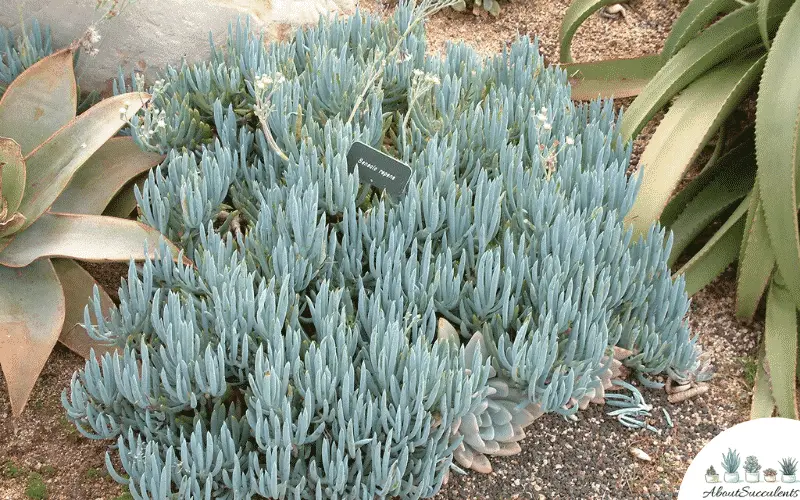
Senecio serpens is a tantalizing succulent plant. It has bluish-green leaves that appear to be dusted with chalk and are reaching up to the sky. The elongated, upward-moving direction of its leaves and its powdery/chalk-like edges have given Senecio serpens the nickname “Blue Chalksticks”.
When Senecio serpens is given enough sunlight, the edges of its leaves turn purple.
Blue Chalksticks can grow up to 36-inches or 91cm. It comes from the Asteraceae family and is native to South Africa. The succulent blooms small, white flowers in the summertime.
General Information:
Also known as: Blue Chalksticks, Blue Chalk Sticks
Plant Family: Asteraceae
Origin: South Africa
Height: 36-inches or 91cm tall
Exposure: Partial to light sunlight
Water Needs: Water only when soil is dry to the touch, little watering during the winter months.
Soil Type: Cactus soil or potting soil mixed with coarse sand or perlite at a 1:1 ratio
Soil pH: Acidic (6.0to 7.0 pH)
Tolerance: Drought
How to Grow and Care for Senecio Serpens
Senecio serpens is easy to grow and maintain. It is popularly used as a garden cover although you can also grow Blue Chalksticks for container gardens.

1. Sunlight
If used to adorn a container garden or as ground cover, Senecio serpens should be planted in an area the receives 6 to 8 hours of morning sunlight every day.
As an indoor plant, Senecio serpens should be placed near a window that receives the most sunlight per day. You can also place the succulent under a Grow Light for up to 16 hours every day to get the right amount of lighting the plant needs.
2. Watering
Senecio serpens is a succulent plant that is highly tolerant to drought. During the growing season, Blue Chalksticks will hardly need water. Giving the plant more water than it requires will cause its roots to rot.
The recommended schedule is once every three to four weeks. Before watering, make sure the soil is completely dried out. You can do this by feel or by inserting a stick into the soil. If the stick comes out dry, water the plant.
Water the soil until it drips from the drainage holes and accumulates on the tray. Once the tray is filled up, throw away the water. Do not let the plant rest on excess water and avoid watering the leaves.
3. Pot and Soil
Place Senecio serpens in a pot that is big enough to allow its roots to grow. Choose a pot that is made of ceramic material and free of glazing. A ceramic pot encourages evaporation and allows the soil to dry out completely. Make sure the pot has a drainage hole.
The best type of soil for Blue Chalksticks is one that is well-aerated and well-draining. You can opt for cactus soil or specially-formulated succulent potting soil then add perlite or coarse sand at a 1:1 ratio to further improve drainage.
It is recommended to give Blue Chalksticks fertilizer at least once a year. The fertilizer should be diluted to half-strength by adding water and it must be low in nitrogen. The fertilizer will not be necessary if Senecio serpens is planted outdoors.

How to Propagate Senecio Serpens
Senecio serpens is a succulent that can be propagated with three methods: Cuttings, Clumps, and Seeds.
Method 1 – Cuttings
Step 1 – Use a sterilized and sharpened knife or a pair of garden shears to remove a leaf from the stem of the main plant.
Step 2 – Place the leaf on a dry and shaded area for 1 to 2 days or until it has dried out and developed calluses.
Step 3 – Once the calluses have formed, place the leaf on a bed of well-draining soil.
Method 2 – Clumps
Step 1 – Senecio serpens can grow in clumps of small plants. Gently remove the plant from the soil and pull out the clumps.
Step 2 – Replant the clump in its own pot. Make sure to fill in the pot with well-draining soil.
Method 3 – Seed
Step 1 – Before planting the seeds, make sure the temperature is warmer or that you are using a seed warmer or a Grow Light.
Step 2 – Plant the seeds in well-draining soil.
Step 3 – Water the soil whenever it is dry to the touch. Germination may take several weeks.
Frequently Asked Questions
Is Senecio Serpens Toxic for Cats and Dogs?
Senecio serpens is not included in the list of plants that are toxic to cats and dogs that appear on the website of the American Society for the Prevention of Cruelty to Animals (ASPCA).
Keep in mind that the list does not cover all succulent plants. If your pet ingests a part of Blue Chalksticks and starts to vomit or show signs on gastrointestinal distress, bring the animal to the Veterinarian immediately.
Why is my Senecio Serpens Succulent Dying?
Your Senecio serpens succulent could be dying because of 3 possible reasons: Overwatering, etiolation, and pest infestation.
1. Overwatering
Senecio serpens may be a resilient succulent plant but like other varieties it can die because of overwatering.
When you give Blue Chalksticks too much water, its roots will rot and develop infection that can spread throughout the plant. You will know if the plant’s roots are rotting if you notice its leaves turning brownish or blackish in color.
To save Senecio serpens, cut off the infected areas with a sterilized and sharpened knife or a pair of garden shears.
Next, prepare the plant for re-potting. Gently remove Senecio serpens from the soil. Shake off excess soil and look for roots that may be rotting. Cut off all roots that have started to rot.
While Blue Chalksticks is drying out, prepare a new ceramic pot. Fill it up with well-draining potting soil and re-plant Blue Chalksticks.
2. Etiolation
Etiolation is a condition that is caused by a severe lack of water. The succulent’s leaves will start stretching further out to search for water. If this happens, the leaves become overly stretched out and limp.
If Senecio serpens experiences etiolation, cut off the stretched out leaves and place the plant in an area where it can receive 6 hours of sunlight. The plant should be fine after getting enough sun exposure.
3. Pest Infestation
Succulent varieties such as Senecio serpens attracts mealybugs and aphids. These pests can kill your succulent by drinking away its precious sap.
To keep pests away from Senecio serpens, spray it with neem oil at least once a week and remove dead leaves from the base of the plant.
Mealybugs will leave white, cotton-like substances on the plant. You can remove these substances with a cotton tip that is dipped in denatured alcohol.
Does Senecio Serpens Produce Flowers
Yes, Senecio serpens produce small, white flowers in the summertime.
Last Updated on June 10, 2022 by Sofia Lara